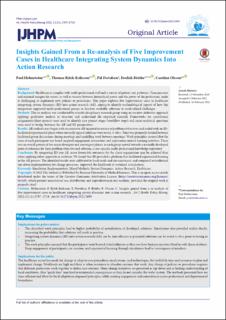| dc.contributor.author | Holmström, Paul | |
| dc.contributor.author | Björk-Eriksson, Thomas | |
| dc.contributor.author | Davidsen, Pål Ingebrigt | |
| dc.contributor.author | Bååthe, Fredrik | |
| dc.contributor.author | Olsson, Caroline | |
| dc.date.accessioned | 2023-03-29T10:56:05Z | |
| dc.date.available | 2023-03-29T10:56:05Z | |
| dc.date.created | 2022-12-14T10:53:49Z | |
| dc.date.issued | 2022 | |
| dc.identifier.issn | 2322-5939 | |
| dc.identifier.uri | https://hdl.handle.net/11250/3060870 | |
| dc.description.abstract | Background
Healthcare is complex with multi-professional staff and a variety of patient care pathways. Time pressure and minimal margins for errors, as well as tension between hierarchical power and the power of the professions, make it challenging to implement new policies or procedures. This paper explores five improvement cases in healthcare integrating system dynamics (SD) into action research (AR), aiming to identify methodological aspects of how this integration supported multi-professional groups to discover workable solutions to work-related challenges.
Methods
This re-analysis was conducted by a multi-disciplinary research group using an iterative abductive approach applying qualitative analysis to structure and understand the empirical material. Frameworks for consultancy assignments/client projects were used to identify case project stages (workflow steps) and socio-analytical questions were used to bridge between the AR and SD perspectives.
Results
All studied cases began with an extensive AR-inspired inventory of problems/objectives and ended with an SDfacilitated experimental phase where mutually agreed solutions were tested in silico. Time was primarily divided between facilitated group discussions during meetings and modelling work between meetings. Work principles ensured that the voice of each participant was heard, inspired engagement, interaction, and exploratory mutual learning activities. There was an overall pattern of two major divergent and convergent phases, as each group moved towards a mutually developed point of reference for their problem/objective and solution, a case-specific multi-professional knowledge repository.
Conclusion
By integrating SD into AR, more favourable outcomes for the client organization may be achieved than when applying either approach in isolation. We found that SD provided a platform that facilitated experiential learning in the AR process. The identified results were calibrated to local needs and circumstances, and compared to traditional top-down implementation for change processes, improved the likelihood of sustained actualisation. | en_US |
| dc.language.iso | eng | en_US |
| dc.rights | Navngivelse 4.0 Internasjonal | * |
| dc.rights.uri | http://creativecommons.org/licenses/by/4.0/deed.no | * |
| dc.title | Insights Gained From a Re-analysis of Five Improvement Cases in Healthcare Integrating System Dynamics Into Action Research | en_US |
| dc.type | Journal article | en_US |
| dc.type | Peer reviewed | en_US |
| dc.description.version | publishedVersion | en_US |
| dc.rights.holder | Copyright 2022 The Author(s) | en_US |
| cristin.ispublished | true | |
| cristin.fulltext | original | |
| cristin.qualitycode | 1 | |
| dc.identifier.doi | 10.34172/ijhpm.2022.5693 | |
| dc.identifier.cristin | 2092947 | |
| dc.source.journal | International Journal of Health Policy and Management | en_US |
| dc.source.pagenumber | 2707-2718 | en_US |
| dc.identifier.citation | International Journal of Health Policy and Management. 2022, 11 (11), 2707-2718. | en_US |
| dc.source.volume | 11 | en_US |
| dc.source.issue | 11 | en_US |

